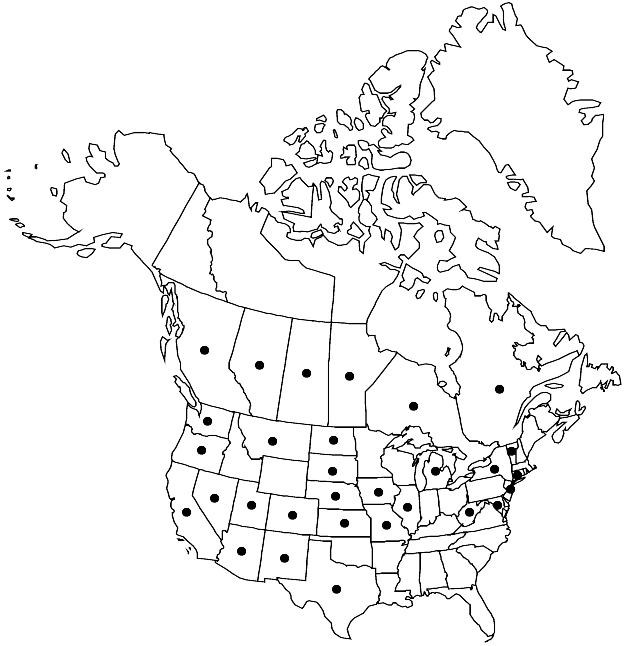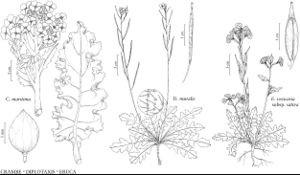Eruca vesicaria subsp. sativa
in G. Hegi et al., Ill. Fl. Mitt.-Eur. 4: 201. 1918.
Stems usually branched basally, (1–) 2–8 (–10) dm, glabrous, hirsute, or hispid. Basal leaves (often withered by fruiting); petiole (1–) 2–5 (–7) cm; blade widely oblanceolate or pinnatisect, (2–) 4–15 (–20) cm × (10–) 20–40 (–60) mm, lobes 3–9 on each side, lobe margins entire or dentate. Cauline leaves (distal) subsessile; blade lobed or not, similar to basal. Fruiting pedicels (subappressed to rachis), 2–8 (–10) mm. Flowers: sepals (6–) 7–10 (–12) × 1.5–2.2 mm, outer pair cucullate or not, glabrous or with subapical tuft of trichomes; petals broadly obovate, (12–) 15–20 (–26) × (4–) 5–7 (–9) mm; median filaments (8–) 10–13 (–15) mm; anthers 2–3 mm. Fruits (1.1–) 1.5–3.5 (–4) cm × (2.5–) 3–5 mm; valves (0.7–) 1–2.5 (–3.2) mm; terminal segment 5-veined, (4–) 5–10 (–11) mm, as long as or slightly shorter than valves. Seeds pale or grayish brown, 1.6–2.5 mm. 2n = 22.
Phenology: Flowering Mar–Sep.
Habitat: Roadsides, disturbed areas, waste places, cultivated fields, dry ditches, rocky outcrops, gravelly slopes, sandy plains, open rangelands
Elevation: 0-1200 m
Distribution

Introduced; Alta., B.C., Man., Ont., Que., Sask., Ariz., Calif., Colo., Conn., Ill., Iowa, Kans., Md., Mich., Mo., Mont., Nebr., Nev., N.J., N.Mex., N.Y., N.Dak., Oreg., Pa., S.Dak., Tex., Utah, Vt., Wash., W.Va., Europe, Africa, also in Mexico, Central America, South America, Asia, Atlantic Islands, Australia
Discussion
Subspecies sativa, widely naturalized and cultivated, was first introduced as a weed in North America in Flathead County, Montana, in 1898, with additional reports from 1900 to the 1920s as a seed contaminant of alfalfa fields in the United States.
Subspecies vesicaria and pinnatifida (Desfontaines) Emberger & Maire are endemic to Spain and North Africa and have escaped from cultivation in Europe; they seem not to have become adventive in North America (R. C. Rollins 1993). Recent molecular studies by S. I. Warwick and L. D. Black (1993) support the treatment of subsp. vesicaria and its presumed derivative subsp. sativa as a single species; subsp. pinnatifida is maintained as Eruca pinnatifida (Desfontaines) Pomel.
The earliest cultivation of subsp. sativa dates back to the ancient Romans and Greeks. It is currently grown in Europe and North America as a salad plant and in Asia for cooking oil and as food for animals. The oil is also used as an industrial lubricant and for cosmetic and medicinal purposes (I. A. Al-Shehbaz 1985). The seed cake and the entire plant are used as fodder for domestic animals. The oil is high in erucic acid and glucosinolates and is known to cause various skin allergies.
Selected References
None.
Lower Taxa
"elongated" is not a number."thick" is not a number."dm" is not declared as a valid unit of measurement for this property."dm" is not declared as a valid unit of measurement for this property.
